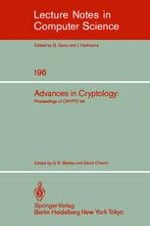1985 | OriginalPaper | Chapter
Authentication Theory/Coding Theory
Author : Gustavus J. Simmons
Published in: Advances in Cryptology
Publisher: Springer Berlin Heidelberg
Included in: Professional Book Archive
Activate our intelligent search to find suitable subject content or patents.
Select sections of text to find matching patents with Artificial Intelligence. powered by
Select sections of text to find additional relevant content using AI-assisted search. powered by
We consider a communications scenario in which a transmitter attempts to inform a remote receiver of the state of a source by sending messages through an imperfect communications channel. There are two fundamentally different ways in which the receiver can end up being misinformed. The channel may be noisy so that symbols in the transmitted message can be received in error, or the channel may be under the control of an opponent who can either deliberately modify legitimate messages or else introduce fraudulent ones to deceive the receiver, i.e., what Wyner has called an “active wiretapper” [1]. The device by which the receiver improves his chances Of detecting error (deception) is the same in either case: the deliberate introduction of redundant information into the transmitted message. The way in which this redundant information is introduced and used, though, is diametrically opposite in the two cases.
